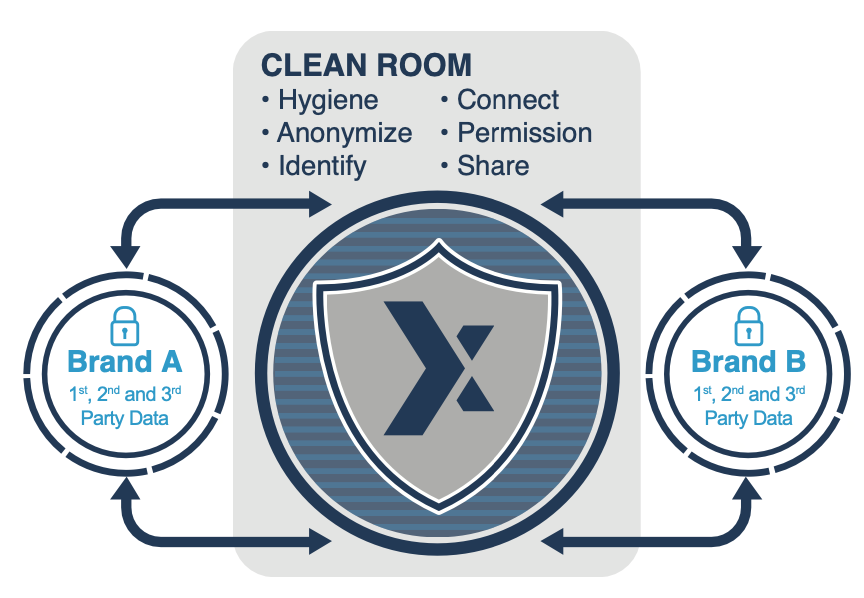A Safe Place to Share Data
Introduction
The term “clean room” is used in the manufacturing industry and scientific community to refer to a place that is free of contaminants. The marketing and technology communities have adopted the term and expanded its meaning to include:
- A trusted safe zone for companies and partners to share data
- A secure data hub for sharing identifiers in a protected and controlled area
- An environment that cleans and unifies data using a common identity key
- A neutral zone with strict access controls powering co-marketing, monetization, analytics, and reporting

Not a New Concept
Even in marketing, the idea of a clean room, a safe and compliant space where two or more parties can share data, is not new. It’s really quite old, but it’s gaining momentum because the data revolution and the explosion of channels are leading advertisers to try to figure out new ways to collaborate to reach their consumers, and that includes combining data assets when and where it makes sense and is permissible.
Traditionally, ‘walled gardens’ like Google and Facebook, have used clean rooms; they still do. To protect where and how their data is handled, publishers create controlled environments where they are willing to share some data with advertisers for very specific use cases. Advertisers can also upload their own sensitive data to run analysis and reporting in these environments. Data in these environments is often aggregated and anonymized to ensure privacy compliance and remove risk.
However not all advertisers find this solution appealing, because they don’t want to share their first-party data with parties, who may become competitive to their own business, if they aren’t already. Additionally, this walled-off approach prevents a holistic view of marketing activity, making it hard for advertisers to fully understand and measure how their marketing is performing. It’s challenging and no fun for advertisers and their data scientists, who are constantly looking for ways to understand what is and is not working.

Today’s Applications
Clean rooms are a good option for advertisers who want to create a safe, privacy-compliant space to bring together data with partners for approved and agreed- upon use cases. Some great examples include:
1. Co-branding/co-marketing opportunity analysis. Do you have a partner(s) who has a client or prospect base that is similar to yours, e.g. hotel + airfare, retail + CPG, restaurant brand + credit card? A clean room could allow you to do a gap analysis to understand the potential opportunities for working together and driving greater engagement and revenue for you both.
2. Neutral third-party measurement. Do you really know how your marketing is performing across channels and which audiences are responding and how? A clean room would allow you to bring together your first-party data with one to many publishers’ exposure data for true omnichannel measurement, giving you the power to know where to spend your next marketing dollar.
3. Loyalty opportunities. Are there other brands adjacent to yours that could become a meaningful part of your loyalty program? A clean room could help you work with potential partners to create a more meaningful loyalty program that results in greater customer retention and more revenue.
4. Audience creation and activation. Could your online/offline campaigns benefit from custom audiences created from your personally identifiable information and partner data? A clean room is an ideal place to join customer data from multiple sources and create unique, engaging messages to your customers. Those audiences can be activated and measured across channels.
5 Key exchanges to share data without sharing name, address or phone number.
Why It’s Trending Again
We live in the age of data. There is no denying it. We are constantly creating and consuming data with each interaction, from the moment we wake up and grab our smartphones, to the moment we go to bed. It’s data all day every day. Consumers use data for everything from making a smart purchasing decision to planning a vacation to finding the best place to eat to tracking their fitness. In turn, companies collect data so they can have a better relationship with their customers and serve them relevant content and experiences. But data collection is tricky and can carry risk.
With laws like GDPR in Europe, CCPA in California and more on the way, government regulators increasingly understand the importance of businesses complying with ethical data collection, storage and usage practices. Most importantly, they are focused on consumers’ ability and right to know what data is being collected about them, how it may be used and, to be able to be in control. But this is not just about privacy laws and who has control of the data; it’s also about transparency. Walled gardens, by definition, are simply not transparent. For advertisers, this means their ability to do effective and holistic measurement and analytics is compromised.
When Google announced its plans to phase out support of third-party cookies, marketers became nervous because the announcement means marketers will potentially have less data to use to make better marketing decisions, impacting not only their budget allocations but also their ability to understand when, where, and how to best connect with consumers.

If you combine all of the recent news and regulations, it’s no wonder data clean rooms are re-emerging as a trending topic. They have the potential to solve multiple problems for creative marketers who are willing to explore and implement this proven concept in new and exciting ways.
Advancements in data sharing technologies, which can be used in clean rooms, further enable data owners to control what data can be shared with partners and for what specific purpose. Clean rooms really do give us the opportunity to make data work harder, in safe, protected ways, creating value for brands, agencies, publishers and critically, consumers.

Successful clean rooms have the following four components:
1. Clear data strategy
- Definition on which data is allowed in the clean room and what the hygiene process should look like
- Understanding which data is permissible for which use cases
- Plan on who can access which data and for which use cases
- Definition on procedures and processes on how the data should be stored and how it should flow to external tools, technologies and connectors (including analytic tools and activation platforms)
2. Safe, secure, privacy-compliant data environment with advanced zoning and permissioning capabilities.
3. Identity services to join disparate data and create a single view of the customer without attaching sensitive data.
4. Flexibility to evolve to meet the ever-changing needs of businesses and users.
Conclusion
Some walled gardens are going to be just that, and they have the size and the
control to own their respective spaces, but that doesn’t mean marketers don’t have
additional options for gaining maximum value from data. In a world where data
regulations and practices are constantly evolving, data clean rooms and collaboration spaces provide opportunities for marketers and brands to find new, innovative, yet safe ways to work together. In addition, working with a neutral third party, like Acxiom, will ensure success as it allows brands to deliver on a cohesive marketing and partnership strategy that includes everything from safe, secure data activation to complete measurement effectiveness. Before you embark on your own data clean room journey, make sure you choose a neutral third party that knows and respects the ethical use of data, has a solid understanding of global data regulations, and can advise you on the best ways to share your most valuable asset, data, with your partners.
Why Choose Acxiom?
15 years
delivering DCR solutions
more than
3 billion records
processed annually for DCR solutions
hundreds of DCR clients
across more than 30
publishers and partners